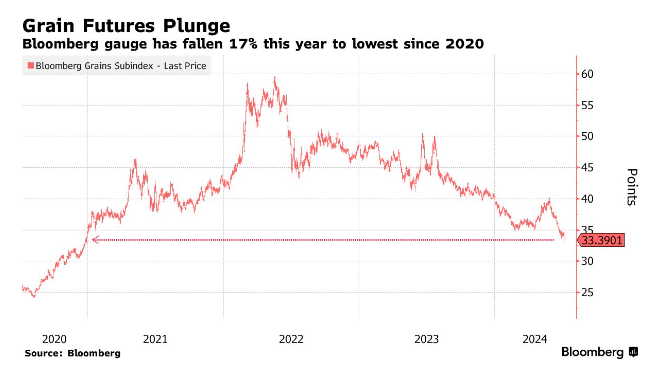Agriculture leaders in the United States House of Representatives are looking to provide at least an additional $10 billion in farmer aid to supplement the recently announced Farmer Bridge Assistance…
Grain Prices Hitting Lowest Levels Since 2020
Bloomberg’s Gerson Freitas Jr and Tarso Veloso reported Monday that “grain prices have slumped to the lowest level since the pandemic as Tropical Storm Beryl is expected to bring rains to the Midwest, potentially aiding yields at a critical time for crop development.”
“The Bloomberg Grains Subindex, which tracks futures for corn, soybeans and wheat in Chicago and Kansas, extended this year’s losses to 17%, trading at the lowest level since December 2020. That’s the worst performance among main commodity groups, with energy and metals indexes rising in 2024,” Freitas Jr. and Veloso reported. “It’s a stark reversal from the post-pandemic rally that sent grain prices more than doubling through 2022, fueling food inflation across the globe.”

In addition, Reuters’ Karen Braun reported Wednesday that “speculators entered July with their most bearish ever midyear views on Chicago corn and soybeans, and prices have recently touched the lowest levels since 2020 as supply fears have all but vanished.”
“In the week ended July 2, money managers expanded their net short in CBOT corn futures and options to 336,538 contracts from 277,666 a week earlier, nearing the all-time short of 340,732 contracts set this February,” Braun reported. “…Money managers for a fifth consecutive week expanded their soy net short, which rose to 140,926 futures and options contracts from 129,663 a week earlier. The record is 171,999 contracts set in early March.”
Price Drops Could Mean Losses for Farmers
The falling U.S. grains prices could mean significant “financial losses for producing corn and soybeans in 2024,” said University of Illinois Agricultural Economist Scott Irwin on the social media platform X.
Using a yield price combination of 240 bushels per acre and $3.70 for corn and 75 bushels per acre and $10.30 for soybeans, Irwin wrote that “without taking into account LDP and crop insurance proceeds, this results in estimated farmer returns of -$244/acre for corn and -$98/acre for soybeans. For farms with 50/50 rotations that results in average farmer returns for all acres of -$171 per acre.”
“Regardless of the fine details of crop insurance payments and gov’t payments, alarm bells should be going off about the scale of potential corn/soybean losses for the 2024 crop in the Corn Belt,” Irwin wrote. “Right now the losses look punishing due to the combination of rising expenses in recent years and the downdraft in corn and soybean prices. Corn losses look like they could easily exceed $200/acre. Of course, the usual caveat applies that this is not a done deal yet. It could still turn hot and dry in the second half of the growing season and prices could rebound.”
5. Last but not least, it is critical to keep in mind that this does not mean that the losses will cause another farm financial crisis. The US crop sector built up large financial reserves in the bonanza years of 2021-22. So, the sector has large liquidity reserves to draw… pic.twitter.com/uFKBjJ2wni
— Scott Irwin (@ScottIrwinUI) July 9, 2024
Why Prices are Declining
Freitas Jr. and Veloso reported that Arlan Suderman, chief commodities economist at StoneX Financial Inc. said in a note to clients that “favorable row crop weather provided the recipe for widespread selling in the grain and oilseed markets, with few buyers jumping in to slow the momentum at this point.”
“Futures of corn for December delivery slumped as much as 4.3% to $4.0575 a bushel.,” Freitas Jr. and Veloso reported. “Soybeans for November dropped as much as 3.1% to $10.9425 a bushel. Both commodities traded at the lowest level since November 2020.”
“Crop prices have also been pressured by sluggish global demand,” Freitas Jr. and Veloso reported. “US exports have been lagging behind, with importers in top commodities buyer China opting for purchases in rival Brazil, where a weaker currency is boosting soybean sales. Meanwhile, American corn growers are holding the largest stockpiles of the grain on their farms since 1988, thanks to high production costs and low prices.”





